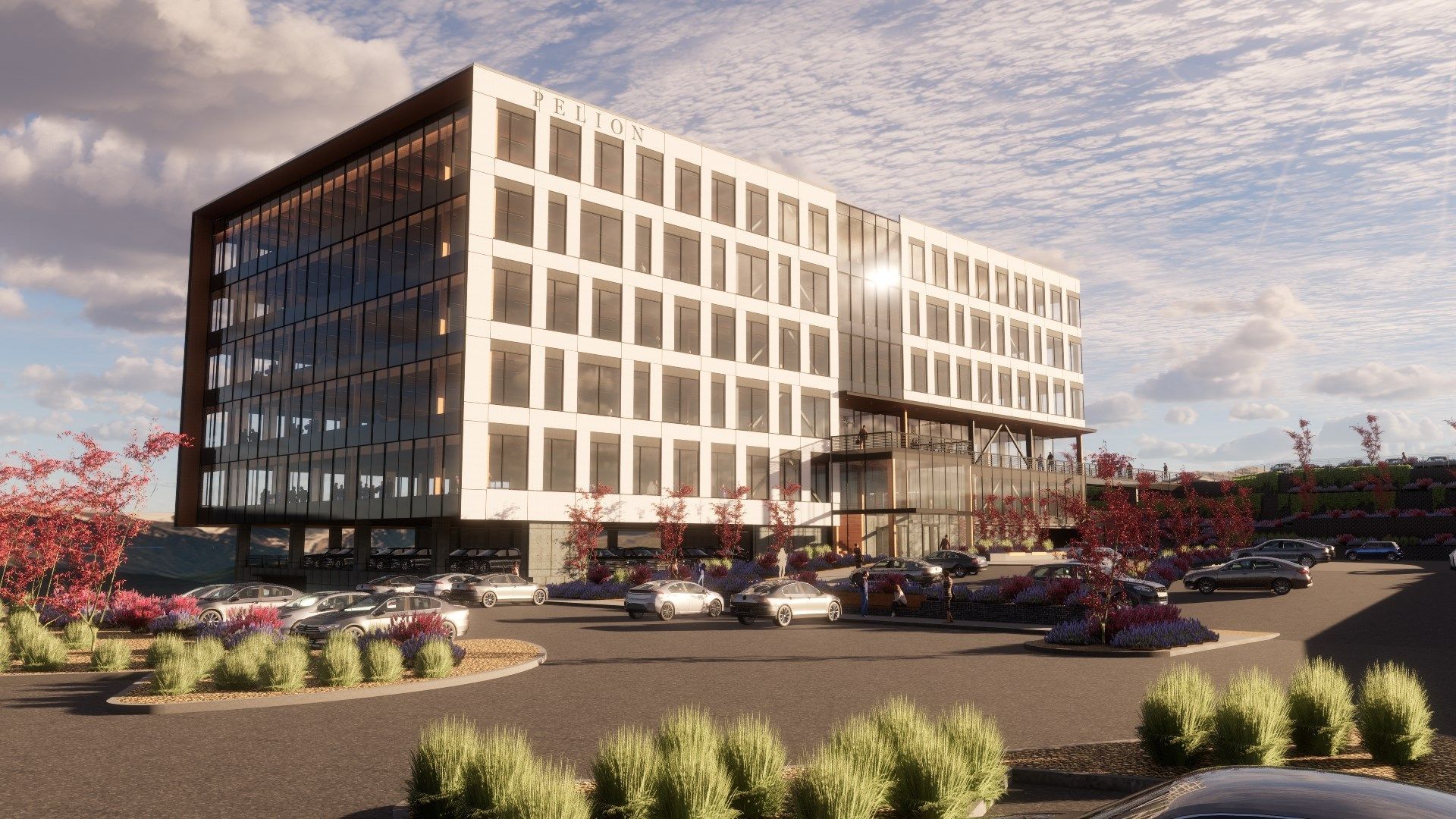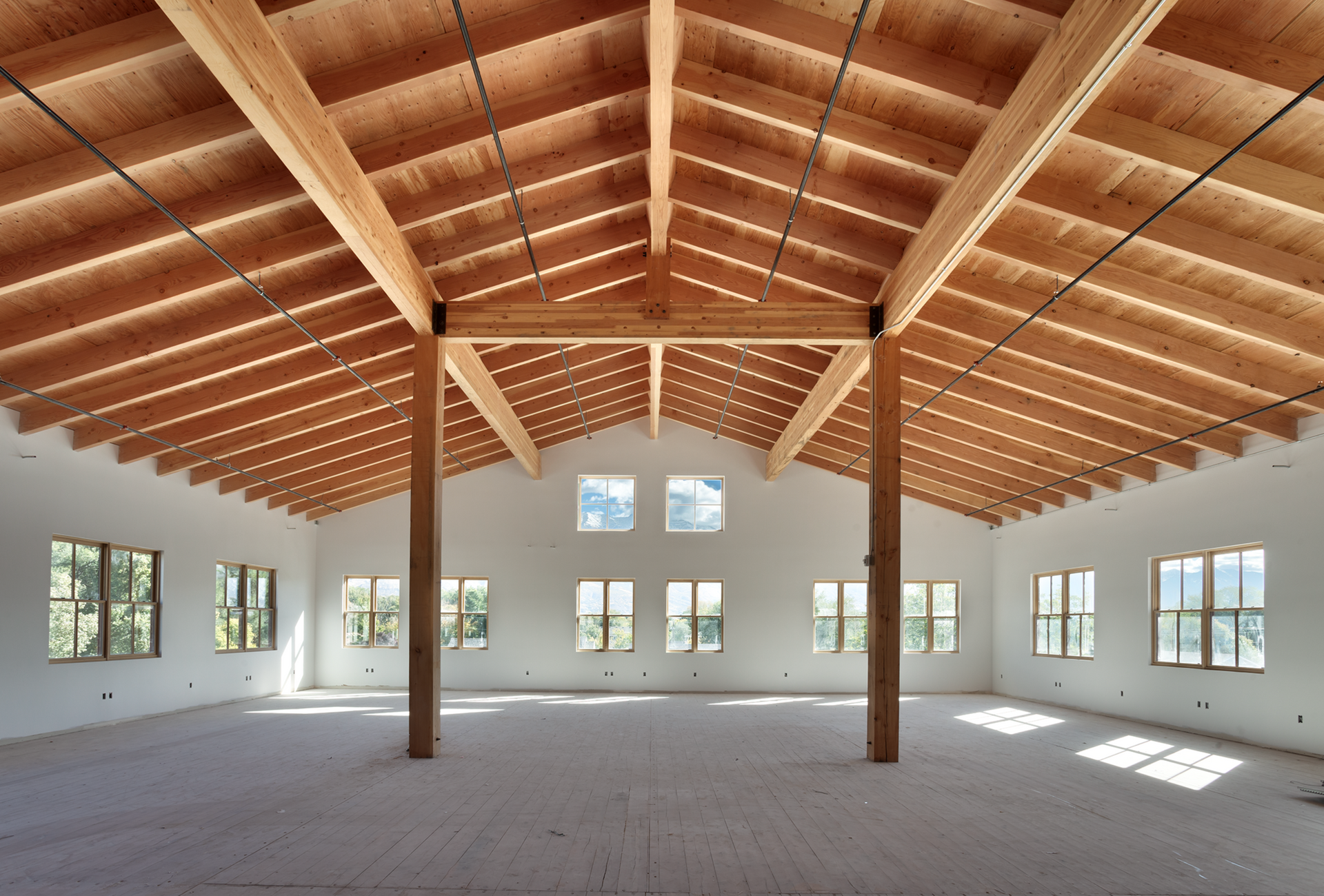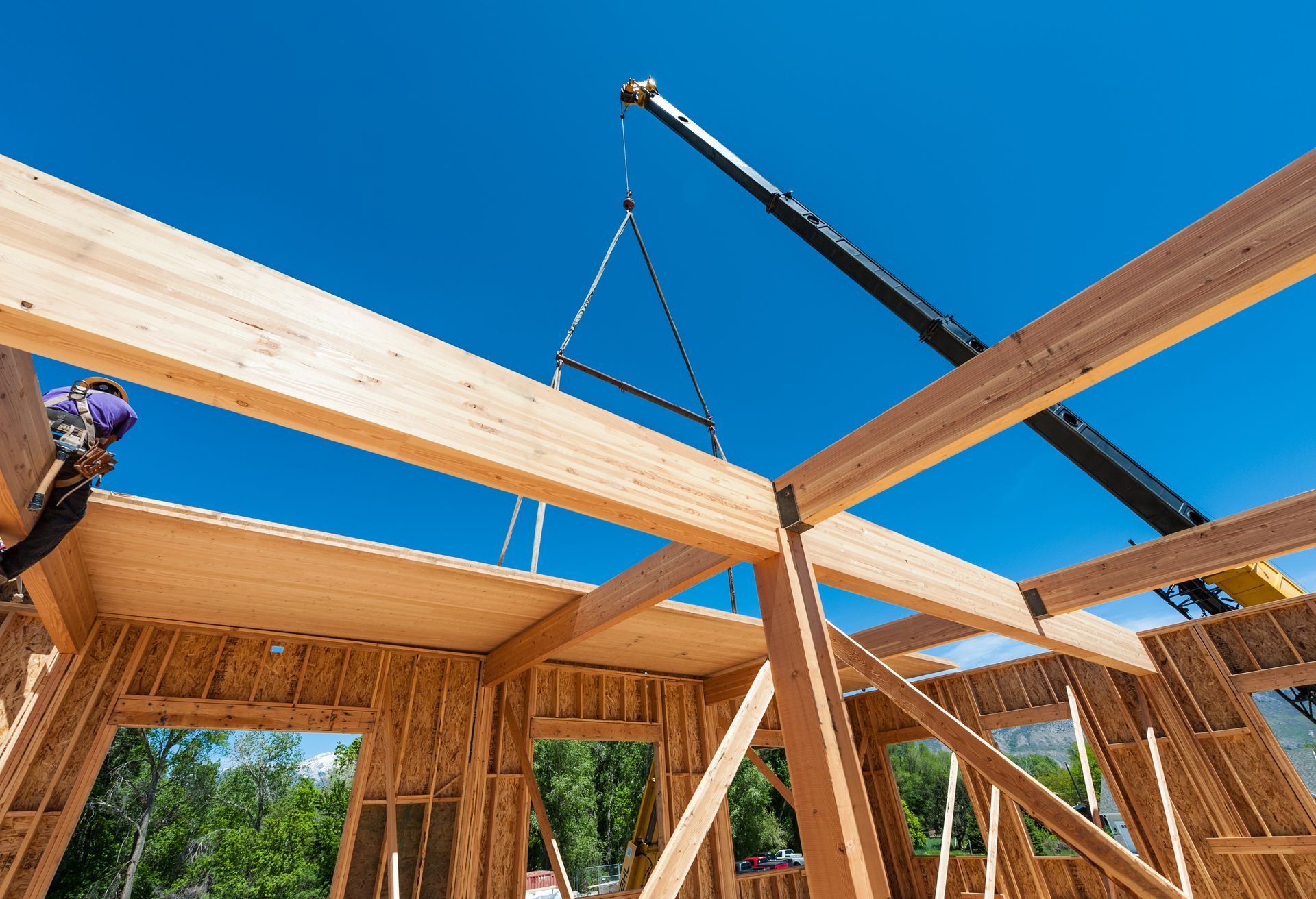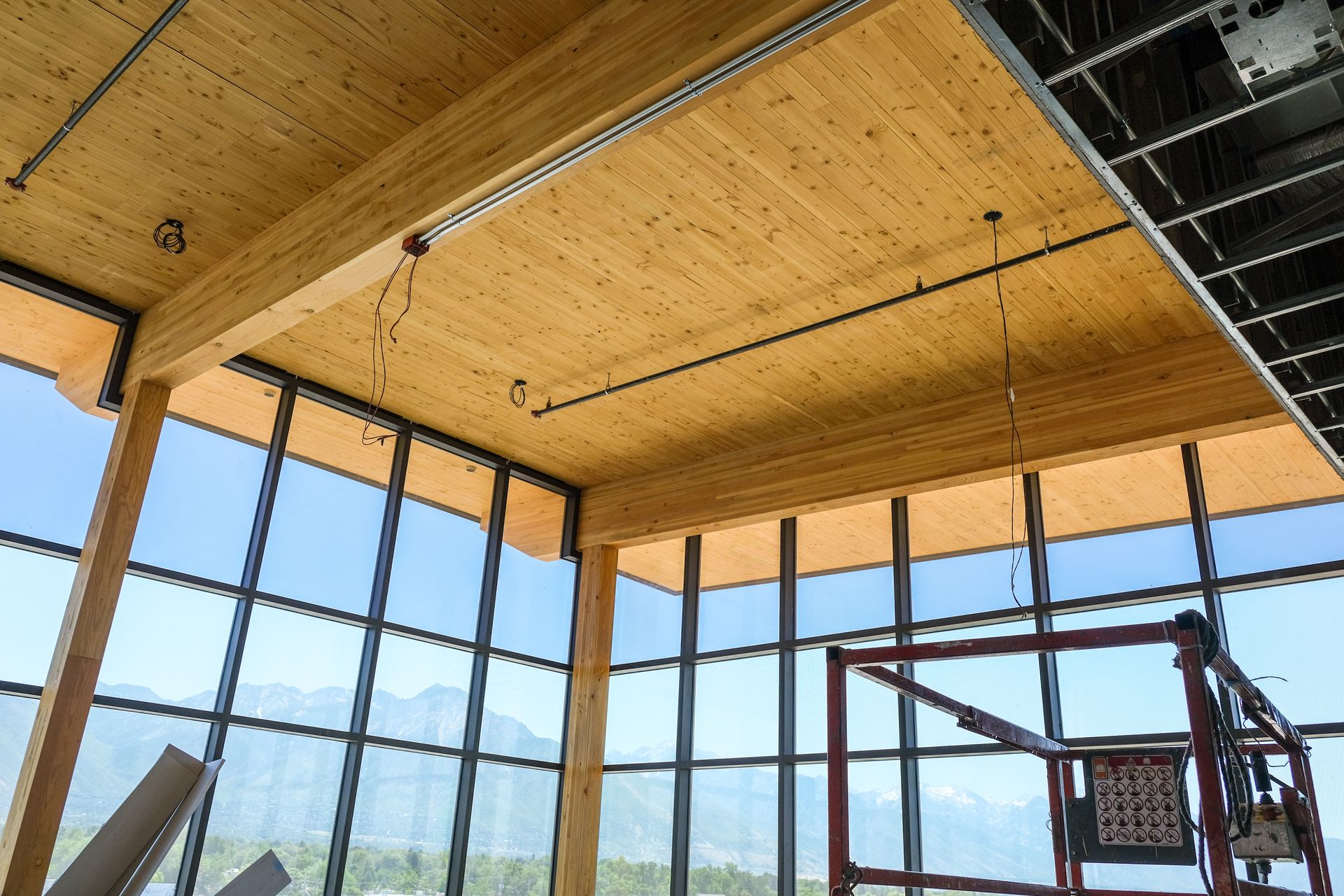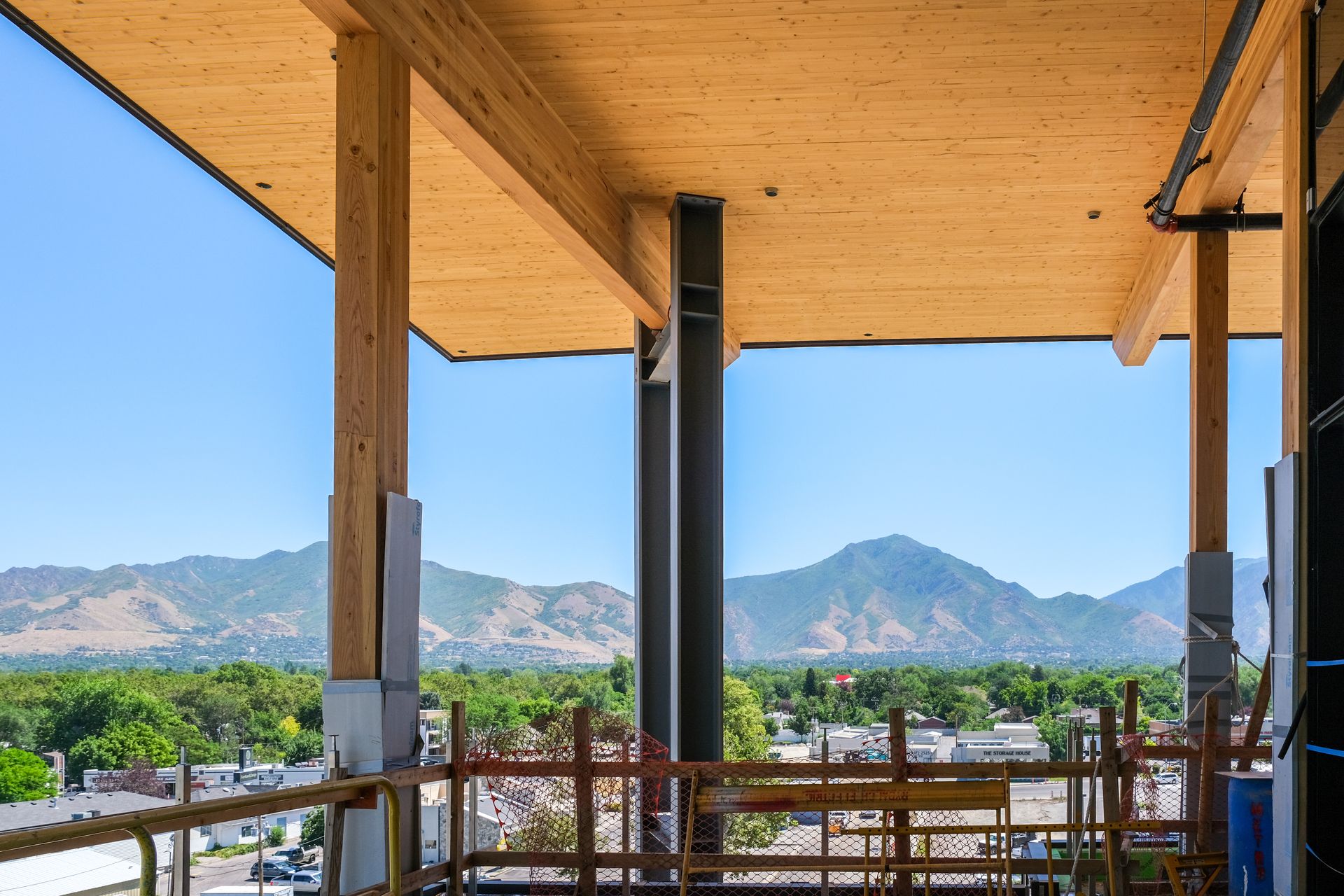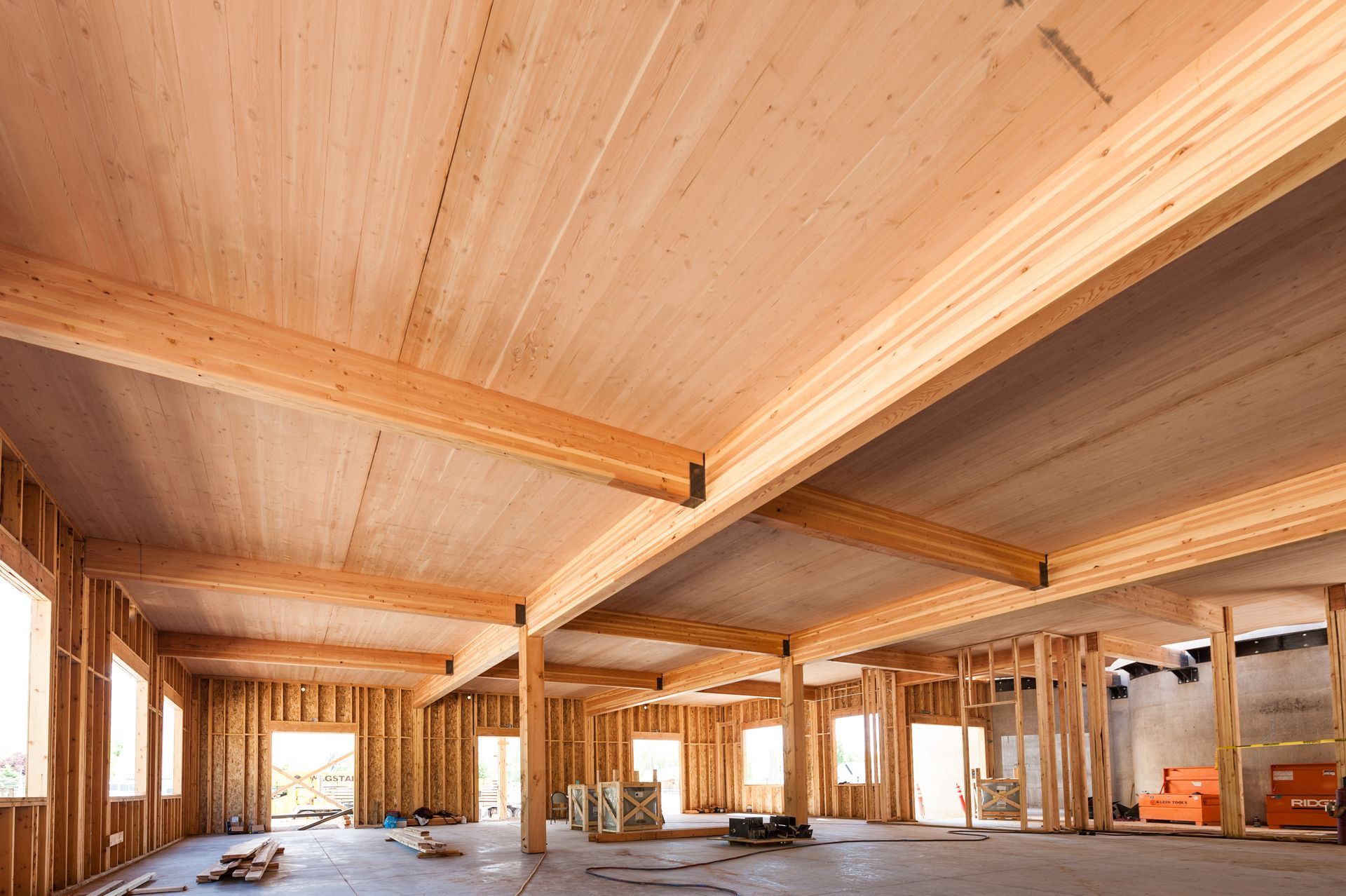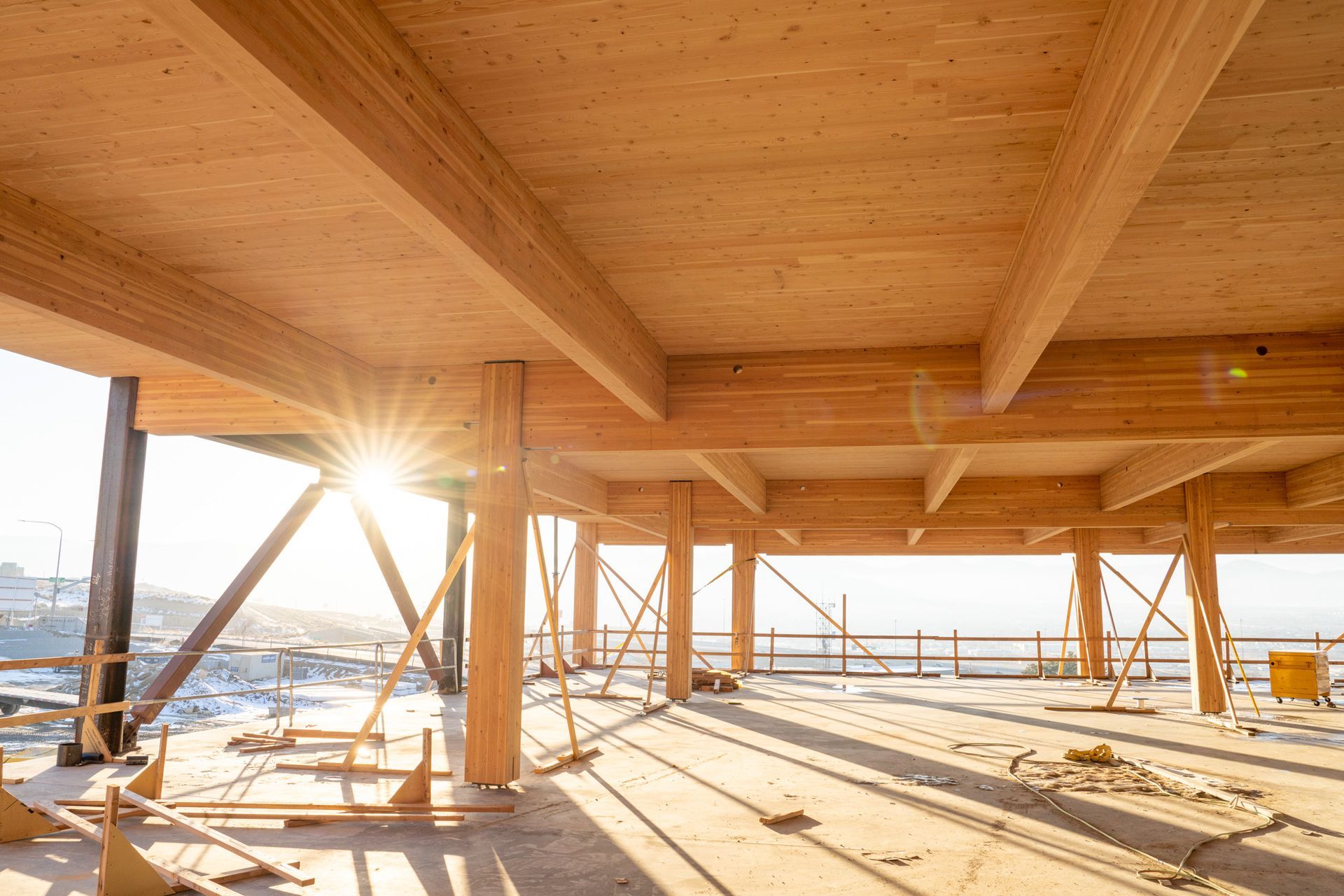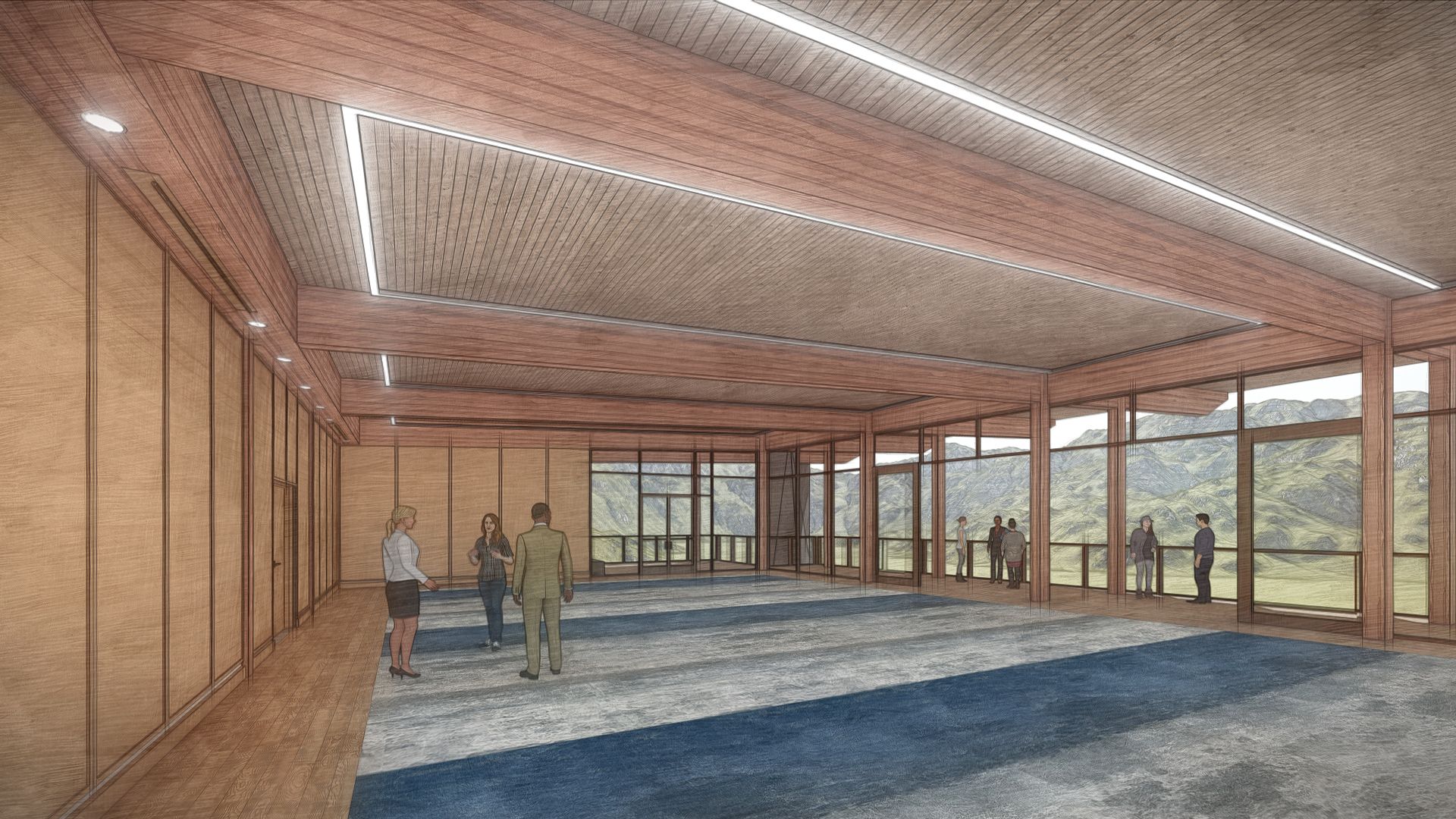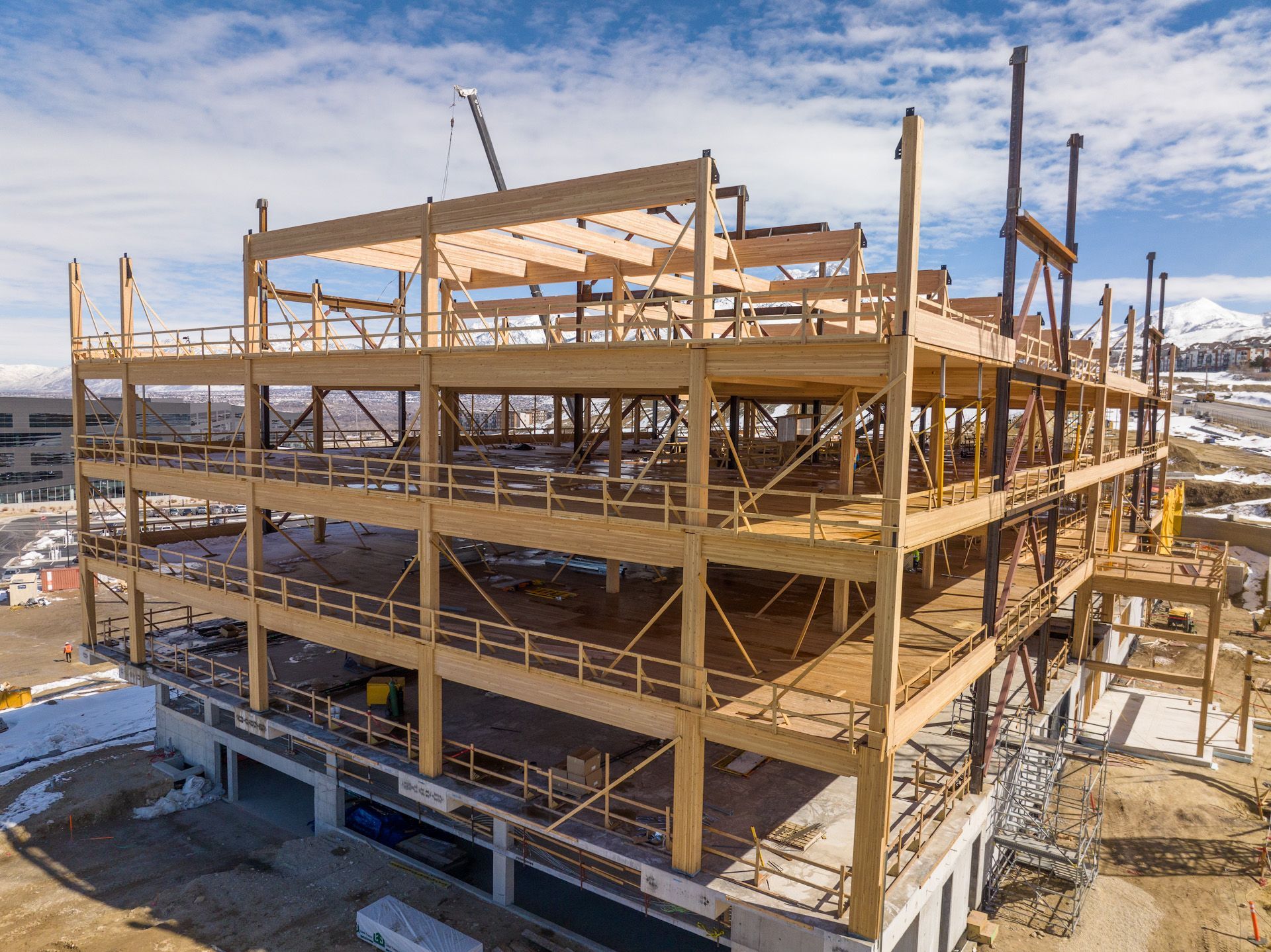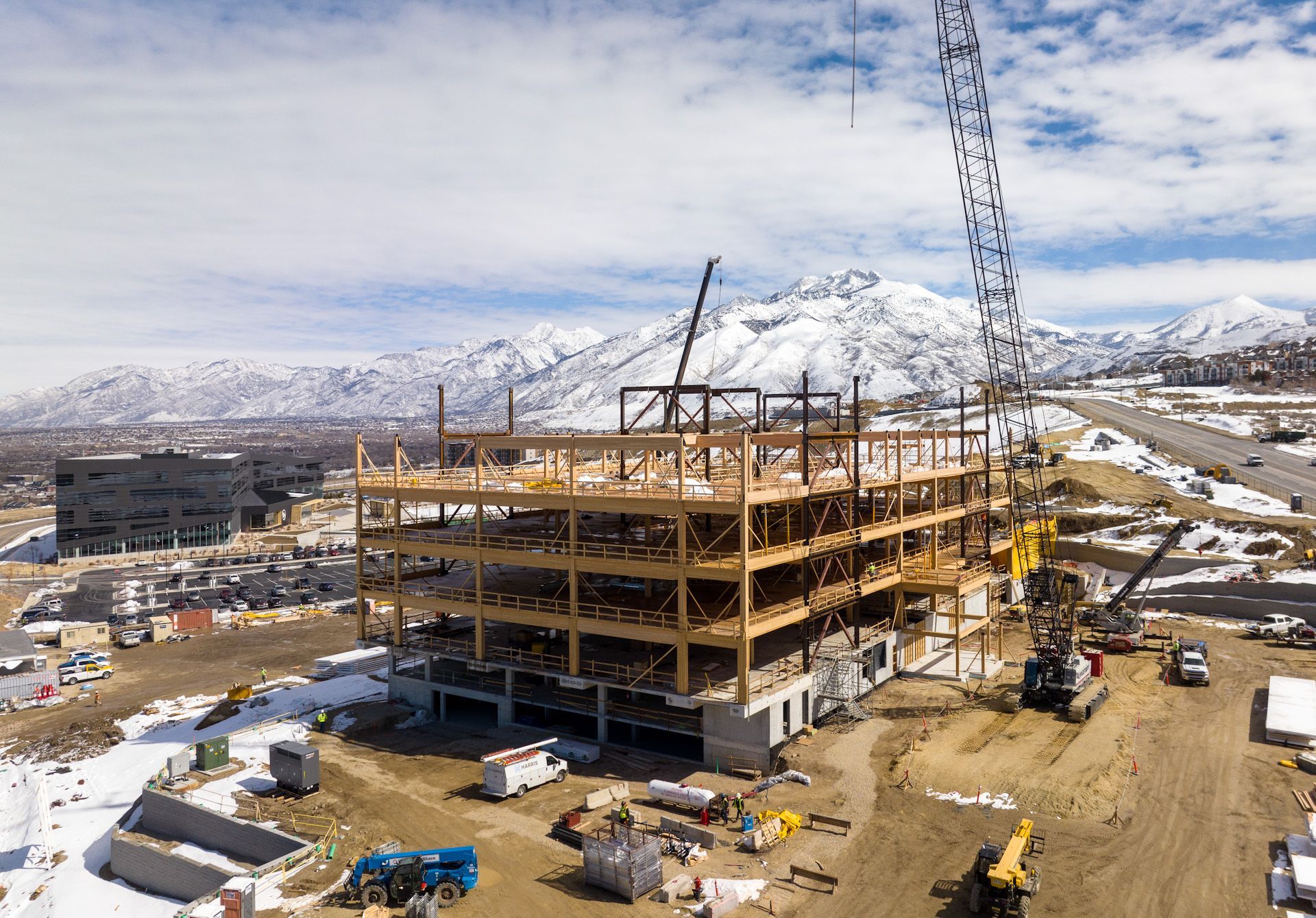Cutting-edge projects like Baltic Pointe—the first full-scale mass timber project in Utah—and Millcreek City Hall are fueling a rising interest in a market eager to gain traction in the Beehive State and beyond. By Brad Fullmer
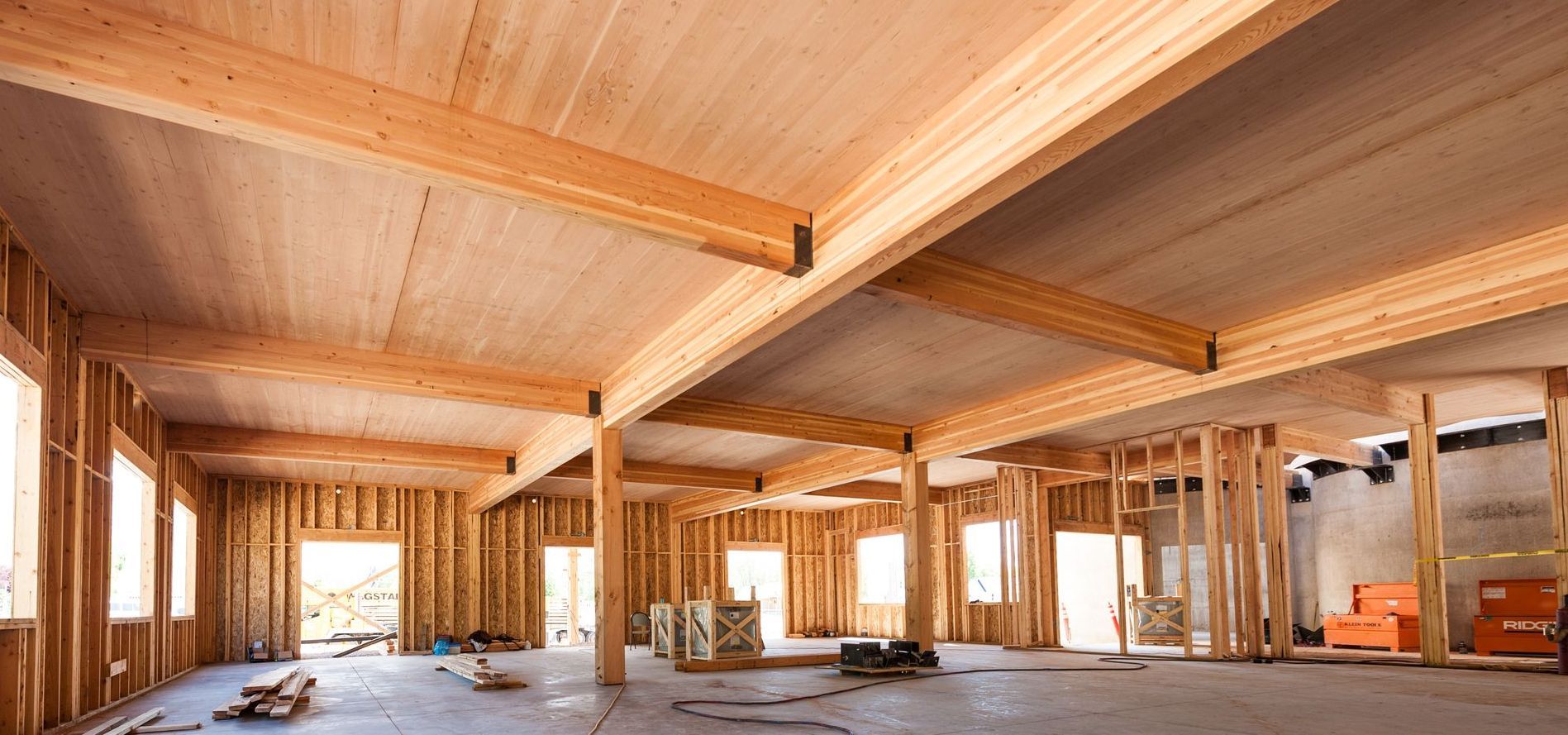
Exterior and interior renderings of Baltic Pointe demonstrate a highly modern, aesthetically cutting-edge building intended to spark discussion about the future of mass timber in this region. (renderings courtesy Method Studio)
Benefits of Mass Timber
Mass timber is a class of wood products made by tightly layering soft lumber boards to create columns, beams, and panels. The products are strong enough to replace steel and concrete in load bearing applications and are slated to be approved for buildings up to 18 stories under the International Building Code (updates are pending).
Structurally, there is confidence in mass timber measuring up well vs. concrete and steel, although there are areas of concern regarding strength and durability that require specific design considerations, which can be overcome for most buildings, said Brett Goodman, Principal for BHB Structural Engineers of Salt Lake.
"Utilizing mass timber in Baltic Pointe brings unique engineering challenges and opportunities," said Goodman. "Integrating mass timber systems requires careful consideration of load-bearing capacities, fire resistance, and dynamic performance. Collaborating with architects and other engineering disciplines, we optimized the structural design to ensure the building's safety, durability, and long-term performance. For the building's seismic design, we kept the high performance of a steel buckling restrained brace frame system (Core Brace) and tied that into the mass timber structure. This was a unique solution that fit the needs of Baltic Pointe."
The floors of Baltic Pointe are comprised of massive Cross Laminated Timber (CLT) panels measuring 5 in. thick by 10 ft. wide by up to 60 ft. long. The CLT is made by “laminating” layers of standard 2x4 to 2x10 members with glue similar to glulam beams. Each layer “crosses" by stacking them perpendicular to the last—the result is one large, stiff wood member that makes for a great floor.
Current testing—funded by the U.S. National Science Foundation—is being done via the Natural Hazards Engineering Research Infrastructure (NHERI) TallWood project, which aims to investigate the resilience of mass timber high-rise buildings by simulating a series of large earthquakes on a full-scale, 10-story mass timber building. Seismic testing is being led by professors from the Colorado School of Mines and University of Nevada, Reno (UNR).
"Resilient design must also account for the building's nonstructural systems, which are not part of the structural load-resisting system but play an important role in the building's function and its ability to recover after the earthquake," said Keri Ryan, project co-investigator and UNR engineering professor.
Approximately 1,500 mass timber projects have been constructed or are in design in the U.S., although few exist in the Intermountain West. Mass timber is largely prefabricated off-site and pieced together like a giant puzzle, so it can facilitate shorter construction times and be completed by a smaller labor force.
Mass timber also aids in reducing construction schedules because "with this kind of construction, as soon as we get the structure up, we don't have to pour decks and fireproof beams—we can start right in with framing and MEP rough ins," said Eric Barton, Project Executive on Baltic Pointe for Salt Lake-based Okland Construction, which is also building Millcreek City Hall.
Thomason said installation of mass timber requires a delicate touch, a process Timber Works has been refining since it installed all the mass timber in the Star Mill project in Alpine in 2015. On that project, Thomason said the mass timber fabricator out of British Columbia was "expensive, did poor quality, hard to work with [...] and once we got the product installed, we thought we should have just (fabricated it) ourselves."
That has evolved into Timber Works offering full-service mass timber fabrication and installation, developing a reputation as a contractor who understands the trade. "I'm vested in the market," said Thomason. "We buy the steel, timber, framing, and offer a turn-key package to our clients. It's a better way to build."
Perhaps the most important benefit—and the one underlying factor that ultimately moves the needle on this market—is the carbon footprint reduction vs. steel or concrete, which are well-known contributors to global CO2 emissions.
According to statistics from 2022, cement and steel production accounts for approximately 11% to 15% of all global CO2 emissions, a major driver of climate change. Replacing these traditional building materials with CLT mass timber would naturally reduce CO2 levels; the use of mass timber on Baltic Pointe reflects a decrease in carbon impact equal to taking more than 1,500 cars off the road for a year or powering 780 homes for a year with renewable energy.
When forests are managed sustainably, wood is a renewable resource and easily sourced in North America. For perspective, it takes about 16 minutes for the wood used in Baltic Pointe to be collectively grown in existing U.S. and Canadian forests.
Other positive factors include mass timber’s high strength-to-weight ratios and natural flexibility, which enable excellent performance during seismic activity. CLT columns and panels also meet or exceed fire code requirements. During a fire, exposed wood chars on the outside, forming an insulating layer that protects the interior from damage the same way redwood trees survive fires.
Mass timber’s aesthetic and environmental appeal are market differentiators that increase a project’s value and lease rate. Research indicates that when people are surrounded by natural materials, it lowers their stress response and improves cognitive function.
On Millcreek City Hall, nature and the community were driving ideas behind incorporating mass timber elements into this dynamic new building, according to Ryan Wallace of Salt Lake-based MHTN Architects. Approximately 12,000 SF of the total 76,000 SF project is constructed of mass timber, including CLT posts, beams, and panels. The rest of the structure is comprised of low-carbon concrete, making for a greatly reduced carbon footprint.
"The potential impact of mass timber construction to de-carbonize the built environment is thrilling to our team and aligned well to Millcreek, a forward-thinking community sensitive to living their motto of being ‘connected by nature’,” said Wallace, adding that it will likely take some time for other public (and private) owners to embrace mass timber.
"Not all owners fall into the category of early adopters willing to take the chance on this re-emerging construction method," said Wallace. "Completed projects, with more predictability of cost, procurement, and quality of construction [...] will be important for the next wave of owners to consider."
Market Outlook
Jake Gines is an Associate Principal at Method Studio, who also happens to be a Professor at Mississippi State University's School of Architecture—he racks up a slew of airline miles commuting between Salt Lake and Starkville during the school year—a position he's held for 11 years. He has been teaching mass timber studios for most of his tenure and believes the CLT market is primed for significant growth, despite the typical cautious approach by owners.
"It's exciting to see a lot of movement in the market," said Gines. "It's the classic chicken and egg thing, where we're not going to supply something until there is a demand. It's been on a slow burn for years."
Gines mentioned new U.S. government grants as helping to generate more interest and activity, but there needs to be even more incentives and additional research into mass timber's long-term viability as an affordable competitor to steel and concrete.
"The gap will close as we understand the material better, get better with engineering, and as more products come along, we can have a more competitive environment," Gines added. "Even though [mass timber] projects cost more, when you look at the material, I think [projects] are very cost competitive. Baltic Pointe is a perfect example of a great team [...] all coming together to create a fantastic project and make some hard decisions on what we can and can't do to make it pencil."



















